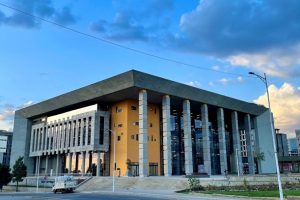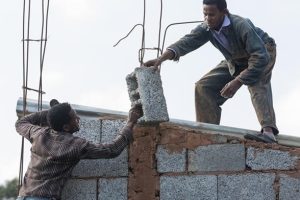

On 19 February 1937, Italian Fascism showed its darkest face. Following the unsuccessful attempt o the life of Graziani by two young Ethiopians, Abraha Dabochand Mogos Asgadom, a reign of terror was unleashed in Addis Ababa,”recounts Prof. Bahru Zewde in his book A History of Modern Ethiopia 1855—1991.
He goes on to write: “With official backing from, the Blackshirts, the political zealots of the Fascist order, went berserk in the city, chopping off heads, burning down houses with their inhabitants, disemboweling pregnant women and committing all manner of atrocities.”
Yekatit 12 Monument, situated at Sidist Kilo Square is dedicated to the martyrs executed summarily in the city. The name Yekatit 12 comes from the date of the Ethiopian calendar that the cruelty unfolded.
The savagery act went only in two years after the capital felled in the hands of the fascist. The two patriots made an assassination attempt on Mussolini’s viceroy, Rudolf Graziani but he survived with minor injuries and retaliated with an indiscriminate and ruthless massacre of many thousand Ethiopians over three days.
As shown in a magazine, Public Monuments of Addis Ababa by MeskeremAssegued, Yekatit 12 monument was designed and sculpted by Antun Augustincic and Fran Krsinic. And Architects–Ante Lozica, JosipFrankol and Ivan Glogoj developed the construction project in detail.
Here are details of the monument credited to Meskerem.
He [Graziani] ordered the use of illegal chemical weapons and bombed the streets and neighborhoods of Addis Ababa and other towns. Many were shot, bludgeoned with shovels, or lynched. Graziani used the attempt on his life to strengthen his control over the country. It also allowed him to demonstrate Italy’s intentions for Ethiopia, which he had outlined previously.
The monument memorializes the lives and tragic deaths of citizens of Ethiopia attacked after the attack on Graziani.
The first Yekatit 12 Monument was dedicated by Emperor Haile Selassie in 1942. It was a rectangular obelisk
measuring 7.5 meters in height and bearing hexagonal motif representing the Emperor. In 1954, Emperor Haile Selassie I visited Yugoslavia and spent time with Marshal Joseph Broz Tito. One outcome of this encounter was the commissioning of Yugoslavia sculptors and architects to create a new statue in Addis Ababa in memory of the massacre. The old monument was replaced in 1955, therefore.
At the Emperor’s request, the sculptors traveled to different parts of Ethiopia to research and record traditional architectural techniques and their cultural significance. Those techniques were to be incorporated into the design. The designers presented three sketches to the Emperor, who selected one that closely resembled ancient Axumite obelisks.
This three-sided, twenty eight meter obelisk sits a top a four meter wide base on a circular foundation. It was carved from over two hundred tonnes of marble quarried from the Adriatic island of Brac, and has a core of reinforced concrete, according to her.
Six steps surrounding the monument’s base are interrupted by three cubic forms spaced along the sides of the obelisk. The closely cut, mortar free appearance of the stonework evokes the craftsmanship evident in the ruins of Yeha in Northern Ethiopia. Two tiers of relief sculptures, each two and a half meters in height, encircle the obelisk, near the base of the monument. Perched on a ledge above them is a lion of Judah.
The upper relief depicts scenes from the three day massacre: the elite forces of the Italian army’s “CamiceNere” (Black Shirts) massacring thousands with civilians dragged to death behind Italian trucks and children being shot. The figures on the upper corners of the bronze reliefs are of three men hung at the gallows, a man in chains, and a woman bearing a man’s severed head on a platter.
The northwest side of the lower relief shows the Emperor giving books to young Ethiopians, while the southwest side shows him addressing Ethiopian governors, generals and soldiers. The lower corners feature a traditional soldier with a shield, a modern soldier with a rifle, and a weaver with a handloom.
Bekelle Mekonnen is an associate professor with Addis Ababa University, School of Fine Arts and Design. He also curved statue of Emperor Haileselassie I that was unveiled at AU headquarters recently.
He says, “Yekatit 12 Monument is one of my best two public monuments found in Addis Ababa, the other one being the Lion of Judah at the National Theatre garden.”
He said that the monument is not only story teller but the indicator of good artistic power.The monument was designed in attractive way.The sculptors tried to show the brutal massacre of Rudolf Graziani on civilians of Addis Ababa and neighboring towns.
The role of monuments standing on public squares like Yekatit 12 are indicating, implying and showing the event or situation in a simplest form and Yekatit12 shows the three bad days of Ethiopians, residents of Addis Ababa. But the detail information must be put in libraries or museums in the form of book, photos of in other forms, to him.
Yekatit12 is standing on the center of Sidist Killo square. The square is very wide. Because of this, it is difficult to see all the figures and to understand the meaning. If someone didn’t see the monument nearly he/she didn’t understand all the figures, according to him.
Intangible Traditional Heritages Senior Researcher with Addis Ababa City Administration Culture and Tourism Bureau, Memhir Mekbeb Gebremariam, as well stated that the main aim of 28-meter tall Yekatit12 monument is to memorize the civilians of Addis Ababa who lost their life with brutal killings of the fascist.
“To him, we have to use our monuments for tourist attraction.In other countries even monuments of tomb are recreational places”, he indicated.
According to him, public Monuments of Addis Ababa are not guaranteed. They are erected on public squares and high traffic area. These monuments are exposed to damages, especially by vehicles. And also it is difficult to visit these monuments because of high vehicle’s flow.
Public squares where monument is located must be free from any movement of vehicles, he concludes.
The Ethiopian herald February 15/2019
BY ABDUREZAK MOHAMMED





